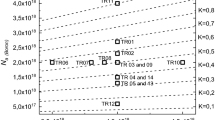Abstract
We have tested a variety of ion-implanted silicon thermistors and a much smaller selection of nuclear transmutation doped germanium devices over a wide range of temperatures and power densities. A small number of melt-doped silicon and germanium devices have also been tested, but these usually show evidence for small-scale doping inhomogeneities that make their behavior unpredictable and generally less desirable for cryogenic detectors.
The behavior of the thermistors falls into fairly simple and predictable patterns. Many of these are not readily explained in terms of current theory, but empirical descriptions permit predictions of thermistor behavior and optimization of the design for best performance in a particular situation.
Both silicon and germanium thermistors show strong non-ohmic effects that severely limit the performance of these devices at low temperatures. This most directly affects the maximum speed of detectors employing them, and appears to limit the response time of detectors operating at 100 mK to the order of 1 ms.
We have also observed excess low-frequency noise in both types of thermistor that appears to be an intrinsic property of the bulk material, since it scales as the square root of the device volume. We have not yet determined how this noise varies with doping density or temperature, but it appears that this phenomenon has a significant effect on detector performance, and will need to be taken into account in an optimum design.
The material for this talk was taken entirely from the following two papers:
J. Zhang, W. Cui, M. Juda, D. McCammon, R. Kelley, H. Moseley, C. Stahle, and A. Szymkowiak, “Hopping Conduction in Partially Compensated Doped Silicon,” Phys. Rev.B48, 2312 (1993)
J. Zhang, W. Cui, M. Juda, D. McCammon, R. Kelley, H. Moseley, C. Stahle, and A. Szymkowiak, “Non-Ohmic Effects in Hopping Conduction in Doped Silicon and Germanium: .05 – 1 Kelvin,” Phys. Rev.B (submitted) (1993/94)
This research is supported by NASA grants NAG5-629 and NAG5-679.




